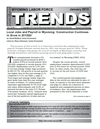
Wyoming Unemployment Rate Falls to 5.1% in November 2012
The Research & Planning section of the Wyoming Department of Workforce Services has reported that the state's seasonally adjusted1 unemployment rate decreased from 5.2% in October to 5.1% in November (not a statistically significant change). In November, Wyoming's unemployment rate was at its lowest level since March 2009. Wyoming unemployment was down from its year-ago level of 5.7% and significantly lower than the current U.S. rate of 7.7%. Seasonally adjusted employment of Wyoming residents decreased by 186 individuals (-0.1%) from October to November.
All county unemployment rates followed their normal seasonal pattern and increased from October to November. As colder weather sets in, employment tends to fall in construction, professional & business services, and leisure & hospitality. The largest increases in unemployment were seen in counties where tourism is an important sector. Teton County's unemployment rate rose from 6.1% to 9.6%, Lincoln County's rate rose from 5.6% to 6.7%, and Park County's rate rose from 4.8% to 5.8%.
Sublette County reported the lowest unemployment rate in November (3.6%). It was followed by Niobrara and Converse counties (both 3.9%). The highest unemployment rates were found in Teton (9.6%), Lincoln (6.7%), and Fremont (6.0%) counties. Most county unemployment rates decreased from November 2011 to November 2012. The largest declines occurred in Teton (down from 11.2% to 9.6%), Johnson (down from 6.1% to 5.3%), and Sheridan (down from 6.1% to 5.4%) counties. In other counties, the over-the-year declines in unemployment were much smaller.
The number of nonfarm jobs in Wyoming (measured by place of work) rose from an estimated 284,700 in November 2011 to 286,000 in November 2012, an increase of 1,300 jobs (0.5%).
1Seasonal adjustment is a statistical procedure to remove the impact of normal regularly recurring events (such as weather, major holidays, and the opening and closing of schools) from economic time series to better understand changes in economic conditions from month to month.

